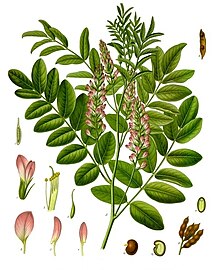
Hornbeams are hardwood trees in the plant genus Carpinus in the birch family Betulaceae. The 30–40 species occur across much of the temperate regions of the Northern Hemisphere.

Liquorice or licorice is the common name of Glycyrrhiza glabra, a flowering plant of the bean family Fabaceae, from the root of which a sweet, aromatic flavouring can be extracted.

Xanthium (cocklebur) is a genus of flowering plants in the tribe Heliantheae within the family Asteraceae, native to the Americas and eastern Asia and some parts of south Asia.

Matricaria is a genus of flowering plants in the chamomile tribe within the sunflower family. Some of the species have the common name of "mayweed", but this name also refers to plants not in this genus.
Wild liquorice or wild licorice typically refers to any of three plants:

Liquorice or licorice is a confection usually flavoured and coloured black with the extract of the roots of the liquorice plant Glycyrrhiza glabra. A wide variety of liquorice sweets are produced around the world. In North America, black liquorice is distinguished from similar confectionery varieties that are not flavoured and coloured black with liquorice extract but commonly manufactured in the form of similarly shaped chewy ropes or tubes and often called red liquorice. Black liquorice, together with anise extract, is also a common flavour in other forms of confectionery such as jellybeans. In addition to these, various other liquorice-based sweets are sold in the United Kingdom, such as liquorice allsorts. In addition to the sweet variations typically found in the United Kingdom and North America, Dutch, German and Nordic liquorice characteristically contains ammonium chloride instead of sodium chloride, prominently so in salty liquorice, which carries a strong salty rather than sweet flavor.

Species Plantarum is a book by Carl Linnaeus, originally published in 1753, which lists every species of plant known at the time, classified into genera. It is the first work to consistently apply binomial names and was the starting point for the naming of plants.

Eriophorum is a genus of flowering plants in the family Cyperaceae, the sedge family. They are found throughout the arctic, subarctic, and temperate portions of the Northern Hemisphere in acid bog habitats, being particularly abundant in Arctic tundra regions.

Glycyrrhiza uralensis, also known as Chinese liquorice, is a flowering plant native to Asia. It is used as a sweetener and in traditional Chinese medicine.

Erigeron acer is a widespread herbaceous flowering plant in the family Asteraceae. Common names include bitter fleabane and blue fleabane. The species is native to Canada, colder parts of the United States, northern, central, and southeastern Asia, and most of Europe.

Ligusticum is a genus of about 60 species of flowering plants in the family Apiaceae, native to cool temperate regions of the Northern Hemisphere. Its name is believed to derive from the Italian region of Liguria.

Rhodiola is a genus of perennial plants in the family Crassulaceae that resemble Sedum and other members of the family. Like sedums, Rhodiola species are often called stonecrops. Some authors merge Rhodiola into Sedum.

Polypodium glycyrrhiza, commonly known as licorice fern, many-footed fern, and sweet root, is a summer deciduous fern native to western North America, where it is found in shaded, damp locations.

Rheum rhabarbarum is a species of flowering plant in the family Polygonaceae, native to a region stretching from southern Siberia to north and central China. It has been harvested from the wild for centuries for its root, which was harvested for use as a popular medicine in Europe and Asia. It was later cultivated for its root in England and Russia. It is considered to be one of the species involved in the development of culinary rhubarb, for which the scientific name R. rhabarbarum is sometimes (erroneously) used.

Licochalcone A is a chalconoid, a type of natural phenol. It can be isolated from the root of Glycyrrhiza glabra (liquorice) or Glycyrrhiza inflata. It shows antimalarial, anticancer, antibacterial and antiviral properties in vitro.

Smilax china is a climbing plant species in the genus Smilax. It is native to China, Korea, Taiwan, Japan, Philippines, Vietnam, Thailand, Myanmar, and India. It also known as china root, china-root, or chinaroot, as is the related Smilax glabra.
Liquorice or licorice is the root of Glycyrrhiza glabra from which a somewhat sweet flavor can be extracted.

Glycyrrhiza echinata is a species of flowering plant in the genus Glycyrrhiza, with various common names that include Chinese licorice, German licorice, and hedgehog licorice, Eastern European licorice, Hungarian licorice, Prickly licorice, and Roman licorice. It is used as a flavoring and medicinally, and to produce Russian and German licorice.
Glycyrrhiza squamulosa, is a plant species in the family Fabaceae, native to China.
Glycyrrhiza yunnanensis, is a plant species in the pea family, Fabaceae, native to China.


















